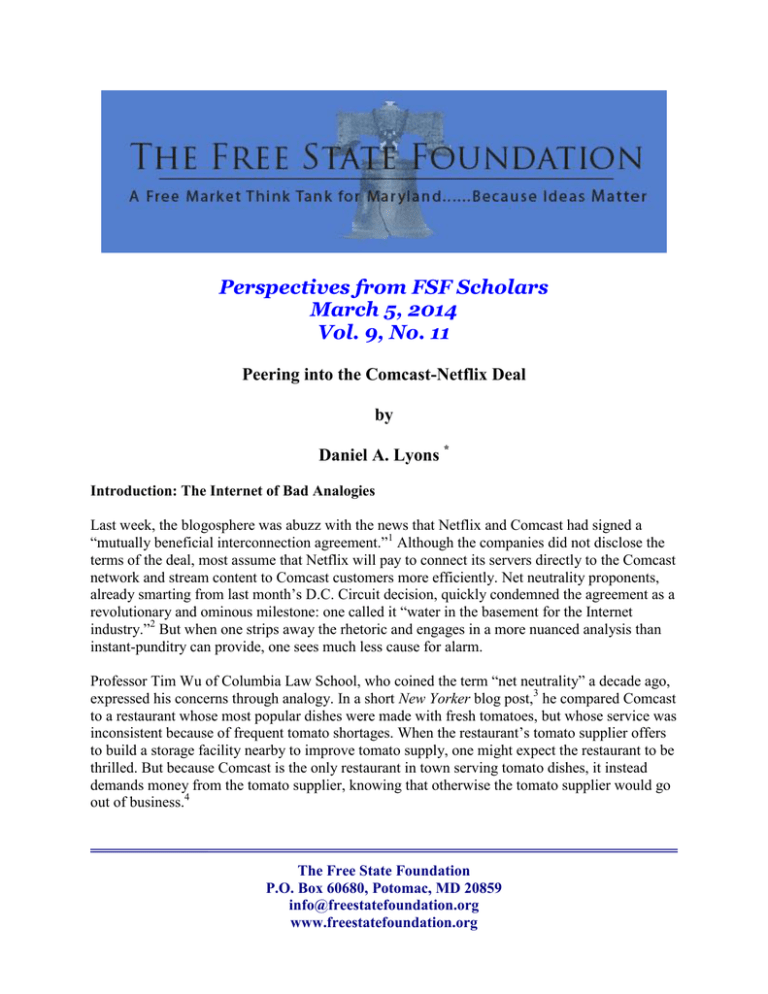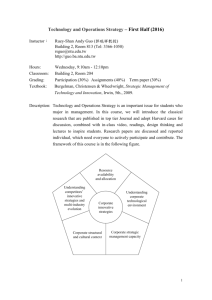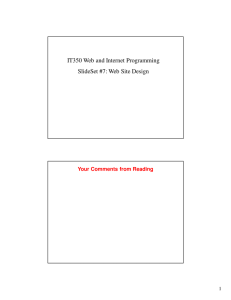Perspectives from FSF Scholars March 5, 2014 Vol. 9, No. 11
advertisement

Perspectives from FSF Scholars March 5, 2014 Vol. 9, No. 11 Peering into the Comcast-Netflix Deal by Daniel A. Lyons * Introduction: The Internet of Bad Analogies Last week, the blogosphere was abuzz with the news that Netflix and Comcast had signed a “mutually beneficial interconnection agreement.”1 Although the companies did not disclose the terms of the deal, most assume that Netflix will pay to connect its servers directly to the Comcast network and stream content to Comcast customers more efficiently. Net neutrality proponents, already smarting from last month’s D.C. Circuit decision, quickly condemned the agreement as a revolutionary and ominous milestone: one called it “water in the basement for the Internet industry.”2 But when one strips away the rhetoric and engages in a more nuanced analysis than instant-punditry can provide, one sees much less cause for alarm. Professor Tim Wu of Columbia Law School, who coined the term “net neutrality” a decade ago, expressed his concerns through analogy. In a short New Yorker blog post,3 he compared Comcast to a restaurant whose most popular dishes were made with fresh tomatoes, but whose service was inconsistent because of frequent tomato shortages. When the restaurant’s tomato supplier offers to build a storage facility nearby to improve tomato supply, one might expect the restaurant to be thrilled. But because Comcast is the only restaurant in town serving tomato dishes, it instead demands money from the tomato supplier, knowing that otherwise the tomato supplier would go out of business.4 The Free State Foundation P.O. Box 60680, Potomac, MD 20859 info@freestatefoundation.org www.freestatefoundation.org If this analogy seems strained, it’s because it is a poor representation of the Internet ecosystem. A diner pays the restaurant for his meal. Tomatoes are an input that the restaurant must secure to provide the finished product for the consumer. But the broadband consumer does not buy Netflix service from Comcast; he buys it directly from Netflix. Netflix must then make arrangements to get its streaming video from its servers to the consumer’s broadband provider—which is a cost of doing its business. Professor Wu and other critics are not disgruntled Italian food patrons; they are more like sports fans who, after buying a stadium ticket, grumble that the venue charges rent to the beer vendor. But even this analogy is imperfect. Internet policy is hard to examine by analogy, as anyone knows who has tried to explain the battle in the Supreme Court’s Brand X decision between Justice Scalia’s Internet-as-pizza-delivery metaphor and Justice Thomas’s preferred Internet-ascar-dealership comparison.5 Rather than refracting reality through distorting lenses of other life experiences, it is better to discard such analogies and discuss in plain terms how Netflix does business and how the Comcast agreement affects its operations. Eliminating the Middleman It is a mistake to assume, as many pundits imply, that Netflix pays nothing to get its content to the Internet. In fact, Netflix purchases Internet transit service from several different networks that are responsible for routing Netflix’s content to the consumer’s broadband provider.6 These transit providers then enter peering agreements to exchange Internet traffic with other networks, such as Comcast. At the risk of simplification, each network typically pays for the information it sends to another network. But if the two exchange roughly the same amount of traffic, they often peer for free (an arrangement sometimes called “settlement-free peering”), because the net payment is likely to be small and would not offset the transaction cost of determining who should pay whom each month. Late last year, some Netflix customers began experiencing delays, which are likely attributable to peering disputes involving one of the company’s primary transit providers, Cogent. As Netflix has grown (to generate almost one-third of all U.S. Internet traffic during peak hours), its transit providers have been required to send ever-larger volumes of Internet traffic to other networks, which can upset preexisting peering agreements. Cogent has been locked in a year-long public peering dispute with Verizon.7 Cogent’s increased volume of Netflix-related traffic has overwhelmed the existing connections between the Cogent and Verizon networks, meaning the connections must be upgraded. Cogent wants to split the cost with Verizon, and to continue exchanging traffic for free. Verizon argues that because Cogent traffic has necessitated the upgrade, Cogent should pay for the upgrades required to handle the increased data. Verizon also wants Cogent to pay for the increased traffic that it is relying on Verizon to deliver. Given that Cogent is collecting from Netflix to deliver the traffic, Verizon’s position is not unreasonable. But until the connections are upgraded, traffic flows are congested and Netflix customers suffer.8 Cogent is involved in peering disputes with many other networks, and analysts suggest that a similar dispute is likely occurring between Cogent and Comcast.9 2 As Netflix’s service quality declined, the company apparently decided to eliminate the middleman. Instead of paying transit fees to Cogent for Comcast-bound traffic, Netflix is instead purchasing that transit directly from Comcast. Netflix’s servers, which reside in third-party data centers, will be physically connected to Comcast network ports located in those data centers. Netflix will then be able to use the Comcast network to send streaming video directly to its customers who receive their broadband connection from Comcast. Streaming Media EVP Dan Rayburn has written a series of excellent posts describing the details.10 And although this appears to be Netflix’s first direct-interconnection deal, these agreements are not uncommon; as Lance Ulanoff notes, Comcast has an entire business unit dedicated to selling these services.11 It’s important to recognize that this is not a new cost imposed on Netflix, as many have suggested— it’s simply a business decision by Netflix to pay Comcast rather than Cogent for meeting some of its transit needs. And while it’s premature to assess the impact of this deal, there appears to be little to worry about from a public policy perspective. Typically, agreements that eliminate a middleman are efficient and welfare-enhancing. Netflix has many options to get its content to the Internet, including continuing its relationship with Cogent or contracting with one of many other transit providers. The fact that it chose a direct interconnection with Comcast suggests that it found this to be the best alternative, either because the price was better or the quality of the service is worth any premium over the next-best alternative. Netflix customers who subscribe to broadband through Comcast should see improved performance, because the data will travel a more direct route from Netflix servers to the customer’s house and will no longer be dependent upon potentially overloaded interconnection bottlenecks. Notably, this deal does not implicate the Federal Communications Commission’s net neutrality rules. Net neutrality prohibited wireline broadband providers from blocking access to lawful Internet content and applications, and from unreasonably discriminating in the delivery of such content to consumers. Although the D.C. Circuit struck down those rules in January,12 the rules remain binding on Comcast until 2018 as a condition of the company’s merger with NBC Universal. While the Commission has suggested that pay-for-priority agreements would violate net neutrality, there is no hint of any such agreement here. The companies have been sparse on the details, but their short press release noted explicitly that “Netflix receives no preferential network treatment under the multi-year agreement.”13 Professor Wu seems to fault Comcast for charging transit fees rather than agreeing to Netflix’s standing offer to use its Open Connect system for free. Open Connect is a content delivery network that Netflix is building as an alternative to Cogent and other transit providers, dedicated to carrying Netflix traffic.14 Netflix hopes that broadband providers will peer with Open Connect and carry Netflix traffic for free. While some smaller providers have signed up, America’s largest broadband providers have thus far declined Netflix’s invitation, which is unsurprising. Settlement-free peering typically occurs between networks that exchange roughly the same amount of traffic. But Open Connect sends much more traffic than it receives from other networks. 3 Contrary to popular opinion, operating a network is not costless. The marginal cost of transporting data may be trivial (at least during periods of non-congestion), but network operators must recover literally hundreds of billions of dollars spent to build America’s networks. Moreover, as the Cogent-Verizon dispute shows, traffic is growing, which necessitates ongoing network upgrades that some estimate will cost $40 billion annually. Some of those tremendous costs can be recovered through end-user subscription fees. But if Netflix is using a network to deliver its product to consumers, it’s not unfair to ask the company to contribute to the cost of building and maintaining that network. Every dollar recovered from a business deal is a dollar less that network providers must recover from consumers. The fact that Netflix pays Cogent and other content delivery networks to provide transit service is uncontroversial. The Netflix-Comcast agreement should be no more controversial just because the identity of the transit provider has changed, or because the transit provider also happens to manage a last-mile broadband network. Conclusion: The Future of Internet Regulation Because of the intense spotlight that commentators have placed on this agreement, it is possible that regulators will begin looking more closely at interconnection agreements and other negotiations between network operators. Traditionally, the Federal Communications Commission has focused primarily on the residential end-user broadband market, and to a lesser extent on commercial broadband access. But many net neutrality proponents have encouraged the Commission to turn its attention upstream in the Internet ecosystem as well. The D.C. Circuit’s Verizon decision recognized that Section 706 of the Telecommunications Act gives the Commission at least some authority to “promulgate rules governing broadband providers’ treatment of Internet traffic” and “how broadband providers treat edge providers.”15 As Professor Christopher Yoo noted in an earlier Free State Foundation Perspectives piece, the scope of that authority is unclear, and there are good arguments to interpret it relatively narrowly. But concern in some circles about the effect of interconnection agreements on markets for Internet content and applications may lead the Commission to test the boundaries of the Verizon decision. But there appears no justification at present for such a radical expansion of the Commission’s mandate. Independently of the legal concerns that Professor Yoo and others have identified, regulatory interference with backbone providers, transit markets, and peering arrangements would simply be bad policy, especially absent strong evidence of a significant market failure. The markets for peering and transit are as robust and competitive as they come. Content providers can choose from a wide range of transit providers, some of which specialize in transit alone, while others provide a variety of complementary services as well.16 Some provide service only within a limited geographic area, while others operate across continents. These networks famously subsist on razor-thin margins. Transit prices have fallen, dramatically, every quarter and will continue to do so for the near future.17 The Netflix deal shows that Comcast may be increasing its footprint in this space. While this step may not be as revolutionary as the blogosphere suggests, it may be somewhat evolutionary. Professor Wu and others are concerned that Comcast may leverage its position as a residential broadband provider to gain an unfair advantage in this upstream market. The robustness of the transit market, and the importance of uninterrupted transit to the functioning of the Internet 4 overall, makes that unlikely. Antitrust law continues to oversee this space, as it does most of the American economy, and it is poised to combat abuses of market power that actually harm consumers. Though Cogent may disagree, Netflix and Comcast’s decision to eliminate the middleman is not inherently anticompetitive and is likely welfare-enhancing because it gets services to consumers faster and with fewer potential interruptions. We should expect this type of creative destruction in markets as dynamic as Internet service, where new innovations demand new and better ways to reach consumers. The agreement may be bad for Cogent and other less efficient providers wedded to the status quo, but it is consistent with an ecosystem that is rapidly changing in capability and complexity. To paraphrase Mark Twain, I suspect that rumors of the Internet’s demise have been greatly exaggerated. * Daniel A. Lyons, an Assistant Professor of Law at Boston College Law School, is a Member of the Free State Foundation’s Board of Academic Advisors. The Free State Foundation is an independent, nonpartisan free market-oriented think tank located in Rockville, Maryland. 1 Press Release, “Comcast and Netflix Team Up to Provide Customers with Excellent User Experience,” Feb. 23, 2014, available at http://corporate.comcast.com/news-information/news-feed/comcast-and-netflix. 2 Edward Wyatt and Noam Cohen, “Comcast and Netflix Reach Deal on Service,” NY Times Feb. 23, 2014 (quoting Tim Wu); see, e.g., Timothy B. Lee, “Comcast’s Deal with Netflix Makes Net Neutrality Obsolete,” Wash. Post The Switch Blog, Feb. 23, 2014, available at http://www.washingtonpost.com/blogs/theswitch/wp/2014/02/23/comcasts-deal-with-netflix-makes-network-neutrality-obsolete/. 3 Tim Wu, “Comcast versus the Open Internet,” New Yorker Elements Blog, Feb. 24, 2014, available at http://www.newyorker.com/online/blogs/elements/2014/02/comcast-versus-the-free-internet.html. 4 Id. 5 See Nat’l Cable & Telecomm. Ass’n v. Brand X Internet Servs., 545 U.S. 967 (2005). 6 See, e.g., Dan Rayburn, “Inside the Netflix/Comcast Deal and What the Media is Getting Very Wrong,”streamingmediablog.com, Feb. 23, 2014, available at http://blog.streamingmedia.com/2014/02/mediabotching-coverage-netflix-comcast-deal-getting-basics-wrong.html. 7 See Jon Brodkin, “Netflix Packets Being Dropped Every Day Because Verizon Wants More Money,” Ars Technica Feb. 21, 2014, available at http://arstechnica.com/information-technology/2014/02/netflix-packets-beingdropped-every-day-because-verizon-wants-more-money/. 8 Id. 9 Dan Rayburn, “Here’s How the Comcast & Netflix Deal is Structured, with Data & Numbers,” streamingmediablog.com, Feb. 27, 2014, available at http://blog.streamingmedia.com/2014/02/heres-comcastnetflix-deal-structured-numbers.html. 10 See Rayburn, supra note 6; Rayburn, supra note 9. 11 Lance Ulanoff, The Comcast-Netflix Deal: Fact vs. fiction, Mashable, Feb. 26, 2014, available at http://mashable.com/2014/02/26/comcast-netflix-net-neutrality/. 12 Verizon v. FCC, 740 F.3d 623 (2014). 13 Press Release, supra note 1. 14 See https://signup.netflix.com/openconnect. 15 Verizon, 740 F.3d at 628, 649. 16 See, e.g., Dan Rayburn, “How Transit Works, What it Costs, and Why It’s So Important,” streamingmediablog.com Feb. 24, 2014, available at http://blog.streamingmedia.com/2014/02/transit-works-costsimportant.html. 17 See, e.g., id.; see also William B. Norton, “The Internet Peering Playbook,” at 33 (2013) (estimating that transit prices have fallen from $1200/Mbps in 1998 to $0.94/Mbps in 2014). 5



